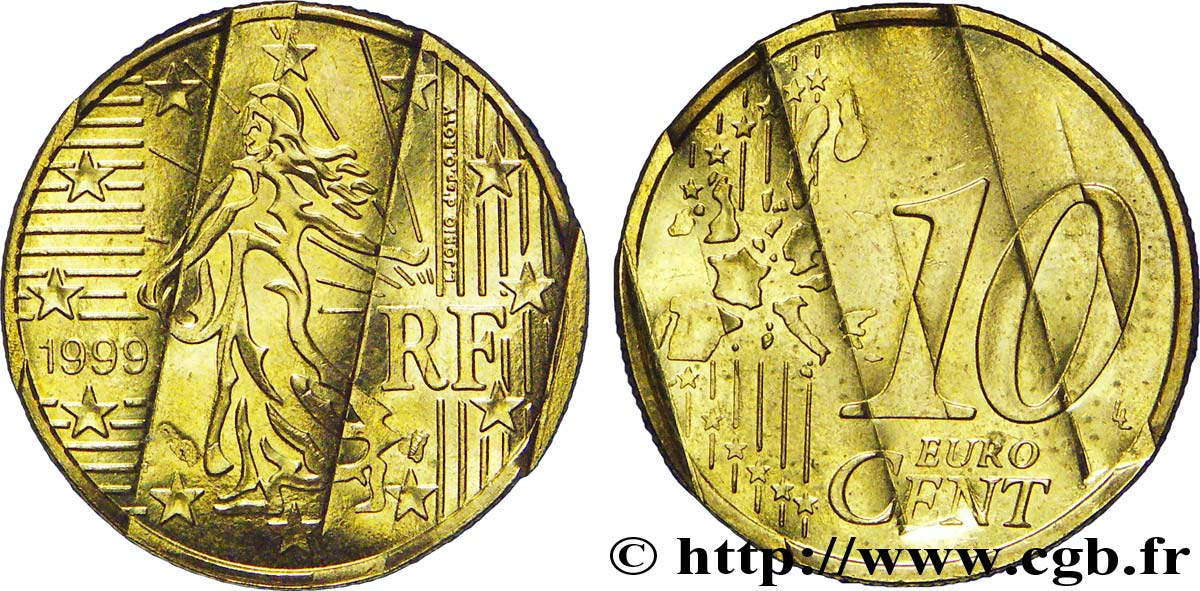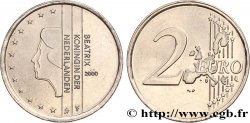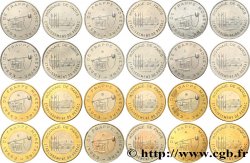- Accueil
- > Archiv
- > Euro Münzen
v44_1146 - EUROPÄISCHE ZENTRALBANK 10 centimes d’euro, premier type avec tranche aux cannelures fines 1999 Pessac
MONNAIES 44 (2010)
Startpreis : 150.00 €
Schätzung : 400.00 €
Erzielter Preis : 189.00 €
Anzahl der Gebote : 3
Höchstgebot : 189.00 €
Startpreis : 150.00 €
Schätzung : 400.00 €
Erzielter Preis : 189.00 €
Anzahl der Gebote : 3
Höchstgebot : 189.00 €
Type : 10 centimes d’euro, premier type avec tranche aux cannelures fines
Datum: 1999
Name der Münzstätte / Stadt : Pessac
Prägemenge : ---
Metall : nordisches Kupfer-Aluminium
Durchmesser : 19,81 mm
Stempelstellung : 12 h.
Gewicht : 4,07 g.
Rand cannelures fines
Seltenheitsgrad : R2
Kommentare zum Erhaltungszustand:
Exemplaire techniquement splendide avec son brillant d’origine mais portant des traces de difformation
N° im Nachschlagewerk :
Vorderseite
Beschreibung Vorderseite La France sous les traits d’une Semeuse marchant à gauche et semant à contre-vent ; derrière le soleil levant ; traits horizontaux à gauche et verticaux à droite avec signature L. JORIO d’ap. O. ROTY ; à gauche de la France, le millésime.
Rückseite
Titulatur der Rückseite 10/ EURO/ CENT.
Beschreibung Rückseite Carte de l’Union européenne sur six traits tirés entre deux groupes de six étoiles formant les douze pays de la zone euro, signature en monogramme LL.
Kommentare
Cet exemplaire fait partie du premier type prévu avec cannelures fines, modifié in extremis lorsque la décision a été prise par Bruxelles de mettre des cannelures larges. La production ayant déjà commencé - les délais sont, ne l’oublions pas, très serrés pour produire des milliards de pièces - tout ce qui avait été fabriqué avec cannelures fines a été détruit, difformé (ce qui explique les marques sur la pièce) et envoyé à la fonte. Quelques poignées de monnaies ont été récupérées chez l’acheteur du lot de métal à fondre et c’est tout ce qui subsiste du “10 cent France 1er type”. Cette monnaie a fait l’objet d’une ligne dans Euro 3, avant les 10 cent “normales” qui deviennent donc “Deuxième type”, car il s’agit d’une fabrication tout à fait officielle.
This example is part of the first type planned with fine fluting, modified in extremis when the decision was taken by Brussels to use wide fluting. Production having already begun - deadlines are, let's not forget, very tight to produce billions of coins - everything that had been manufactured with fine fluting was destroyed, deformed (which explains the marks on the coin) and sent to be melted down. A few handfuls of coins were recovered from the buyer of the batch of metal to be melted down and this is all that remains of the “10 cent France 1st type”. This coin was the subject of a line in Euro 3, before the “normal” 10 cents which therefore become “Second type”, because it is a completely official production
This example is part of the first type planned with fine fluting, modified in extremis when the decision was taken by Brussels to use wide fluting. Production having already begun - deadlines are, let's not forget, very tight to produce billions of coins - everything that had been manufactured with fine fluting was destroyed, deformed (which explains the marks on the coin) and sent to be melted down. A few handfuls of coins were recovered from the buyer of the batch of metal to be melted down and this is all that remains of the “10 cent France 1st type”. This coin was the subject of a line in Euro 3, before the “normal” 10 cents which therefore become “Second type”, because it is a completely official production








 Berichten über einen Fehler
Berichten über einen Fehler Die Seite drucken
Die Seite drucken Teilen meiner Auswahl
Teilen meiner Auswahl Stellen Sie eine Frage
Stellen Sie eine Frage Einlieferung/Verkauf
Einlieferung/Verkauf
 Details
Details









